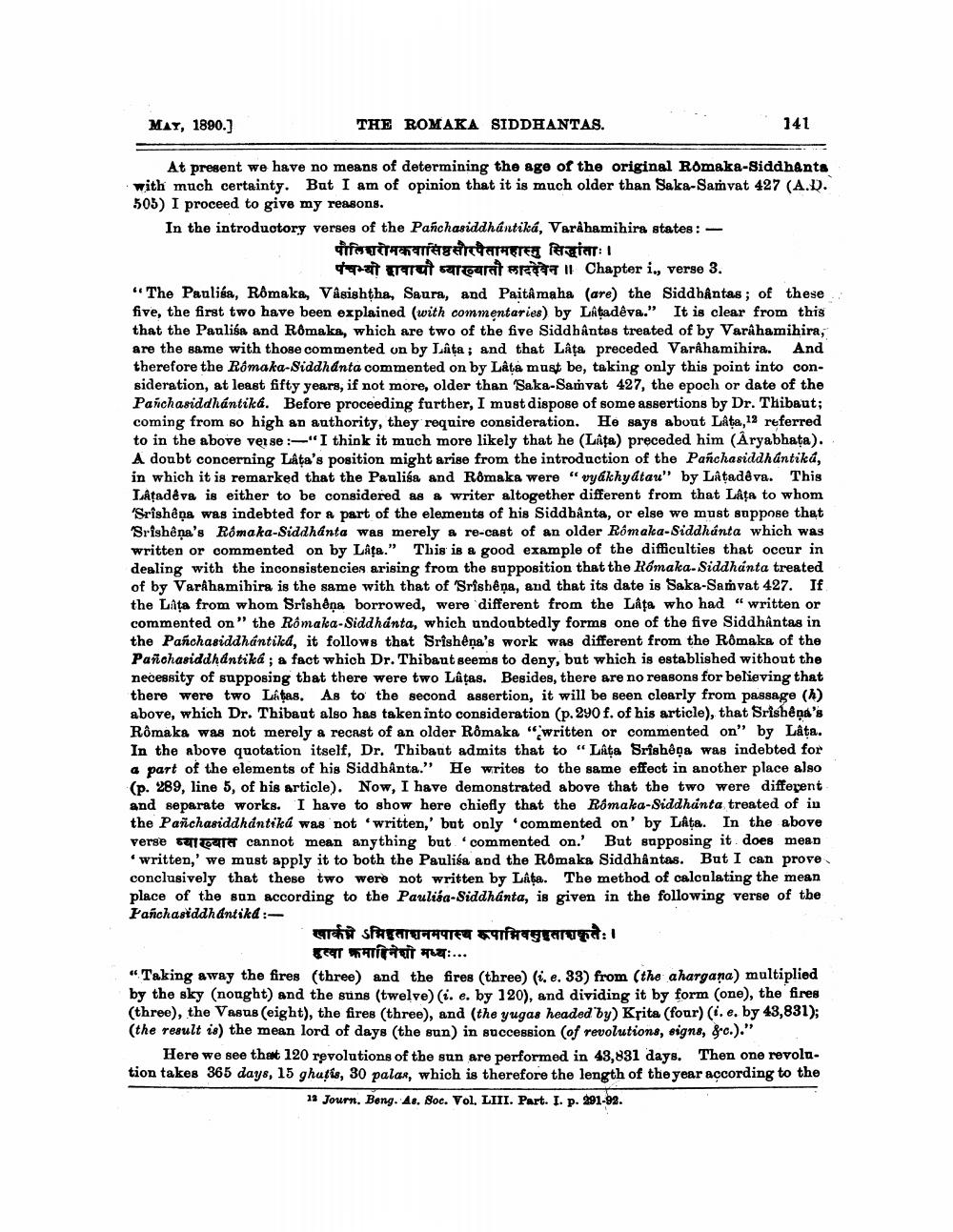________________
MAY, 1890.)
THE ROMAKA SIDDHANTAS.
141
At present we have no means of determining the age of the original Romaka-Siddhants with much certainty. But I am of opinion that it is much older than Saka-Samvat 427 (A.D. 505) I proceed to give my reasons. In the introductory verses of the Panchasiddhántiká, Varahamihira states: -
पौलिशरोमकवासिष्ठसौरपैतामहास्तु सिद्धांताः।
pat garut cart FRITT II Chapter i., verse 3. "The Panlisa, Rômaka, Vâsishtha, Saura, and Paitâmaha (are) the Siddhantas; of these five, the first two have been explained (with commentaries) by Latadêva." It is clear from this that the Panliśa and Romaka, which are two of the five Siddhantes treated of by Varahamihira, are the same with those commented on by Lata ; and that Lâța preceded Varahamihira. And therefore the Rômaka-Siddhanta commented on by Lâtà must be, taking only this point into consideration, at least fifty years, if not more, older than Saka-Samvat 427, the epoch or date of the Panchasiddhantika. Before proceeding further, I must dispose of some assertions by Dr. Thibaut; coming from so high an authority, they require consideration. He says about Lata, 12 referred to in the above verse :-"I think it much more likely that he (Lata) preceded him (Aryabhata). A doubt concerning Låta's position might arise from the introduction of the Panchasiddhantika, in which it is remarked that the Paulisa and Rômaka were "vyakhydtau" by Låtadêva. This LÂţadeva is either to be considered as & writer altogether different from that Laţa to whom Srishêņa was indebted for a part of the elements of his Siddbânta, or else we must suppose that Srishêna's Romaka-Siddhanta was merely a re-cast of an older Rômaka-Siddhanta which was written or commented on by LÂța." This is a good example of the difficulties that occur in dealing with the inconsistencies arising from the supposition that the Rómaka-Siddhanta treated of by Vardhamihira is the same with that of Srisbêņa, and that its date is Saka-Samvat 427. If the Lata from whom Srishēņa borrowed, were different from the Lata who had “written or commented on" the Rômaka-Siddhanta, which undoubtedly forms one of the five Siddhậntas in the Panchasiddhantikd, it follows that Srishêna's work was different from the Rômaka of the Panchasiddhantiká; a fact which Dr. Thibaut seems to deny, but which is established without the necessity of supposing that there were two Latas. Besides, there are no reasons for believing that there were two LÂțas. As to the second assertion, it will be seen clearly from passage (1) above, which Dr. Thibaut also has taken into consideration (p. 290 f. of his article), that Srishêņa's Rômaka was not merely a recast of an older Rômaka "written or commented on" by Låta. In the above quotation itself, Dr. Thibant admits that to “Lata Srishea was indebted for a part of the elements of his Siddhảnta." He writes to the same effect in another place also (p. 289, line 5, of his article). Now, I have demonstrated above that the two were different and separate works. I have to show here chiefly that the Rômaka-Siddhanta treated of in the Panchasiddhdntika was not written,' but only commented on' by Lâţa. In the above verse bar cannot mean anything but commented on. But supposing it does mean written,' we must apply it to both the Paulića and the Rômaka Siddhantas. But I can prove conclusively that these two were not written by Laţa. The method of calculating the mean place of the son according to the Paulisa-Siddhanta, is given in the following verse of the Panchasiddhantikd :
खाने ऽमिहुताशनमपास्वरूपानिवसुहताशकृतेः।
- H ai Ta:... "Taking away the fires (three) and the fires (three) (i.e. 33) from (the ahargana) multiplied by the sky (nought) and the suns (twelve) i. e. by 120), and dividing it by form (one), the fires (three), the Vasus (eight), the fires (three), and (the yugas headed by) Krita (four) (s. e. by 43,831); (the result is) the mean lord of days (the sun) in succession (of revolutions, signs, 8c.)."
Here we see thet 120 revolutions of the sun are performed in 43,831 days. Then one revolution takes 365 days, 15 ghutis, 30 palar, which is therefore the length of the year according to the
13 Journ. Bong. As. Soc. Vol. LIII. Part. I. p. 291-92.




